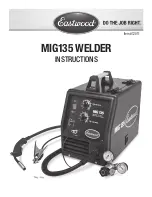
To order parts and supplies: 800.343.9353 >> eastwood.com
11
✓
✓
✓
✓
J1
J3 J2
J4
FIG. J
1.
Replace the wire spool cover.
2.
Plug in welder to your power source and turn on the welder.
3.
Trigger the Spool Gun to feed the wire and adjust the Brass Tensioner Thumb Screw
(FIG. J2)
so that the wire does not slip.
4.
Replace Contact Tip and Nozzle.
5.
Feed wire through the gun and cut the wire exposing a ~3/4" length out of the contact tip.
OPERATION
ELECTRIC SHOCK CAN CAUSE INJURY OR DEATH!
• Improper use of an electric Welder can cause electric shock, injury and death! Read all precautions described in the Welder
Manual to reduce the possibility of electric shock.
• Disconnect Welder from power supply before assembly, disassembly or maintenance of the torch, contact tip and when
installing or removing nozzles.
• Always wear dry, protective clothing and leather welding gloves and insulated footwear. Use suitable clothing made from
durable flame-resistant material to protect your skin.
• If other persons or pets are in the area of welding, use welding screens to protect bystanders from sparks.
• Always operate the Welder in a clean, dry, well ventilated area. Do not operate the Welder in humid, wet, rainy or poorly
ventilated areas.
• The electrode and work (or ground) circuits are electrically “hot” when the Welder is on. Do not allow these “hot” parts to come
in contact with your bare skin or wet clothing.
• Separate yourself from the welding circuit by using insulating mats to prevent contact from the work surface.
• Be sure that the work piece is properly supported and grounded prior to beginning an electric welding operation.
• Always attach the ground clamp to the piece to be welded and as close to the weld area as possible. This will give the least
resistance and best weld.
WELDING SPARKS CAN CAUSE FIRE OR EXPLOSION!
• Electric welding produces sparks which can be discharged considerable distances at high velocity igniting flammable
or exploding vapors and materials.
• Do not operate electric arc Welder in areas where flammable or explosive vapors are present.
• Do not use near combustible surfaces. Remove all flammable items within 35 feet of the welding area.
• Always keep a fire extinguisher nearby while welding.
• Use welding blankets to protect painted and or flammable surfaces; rubber weather-stripping, dash boards, engines, etc.
• Ensure power supply has properly rated wiring to handle power usage.
ELECTROMAGNETIC FIELDS CAN BE A HEALTH HAZARD!
• The electromagnetic field that is generated during arc welding may interfere with various electrical and electronic devices
such as cardiac pacemakers. Anyone using such devices should consult with their physician prior to performing any
electric welding operations.
• Exposure to electromagnetic fields while welding may have other health effects which are not known.
















